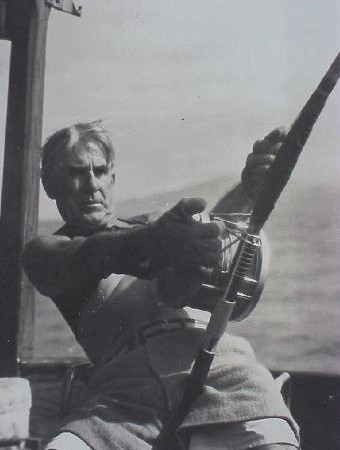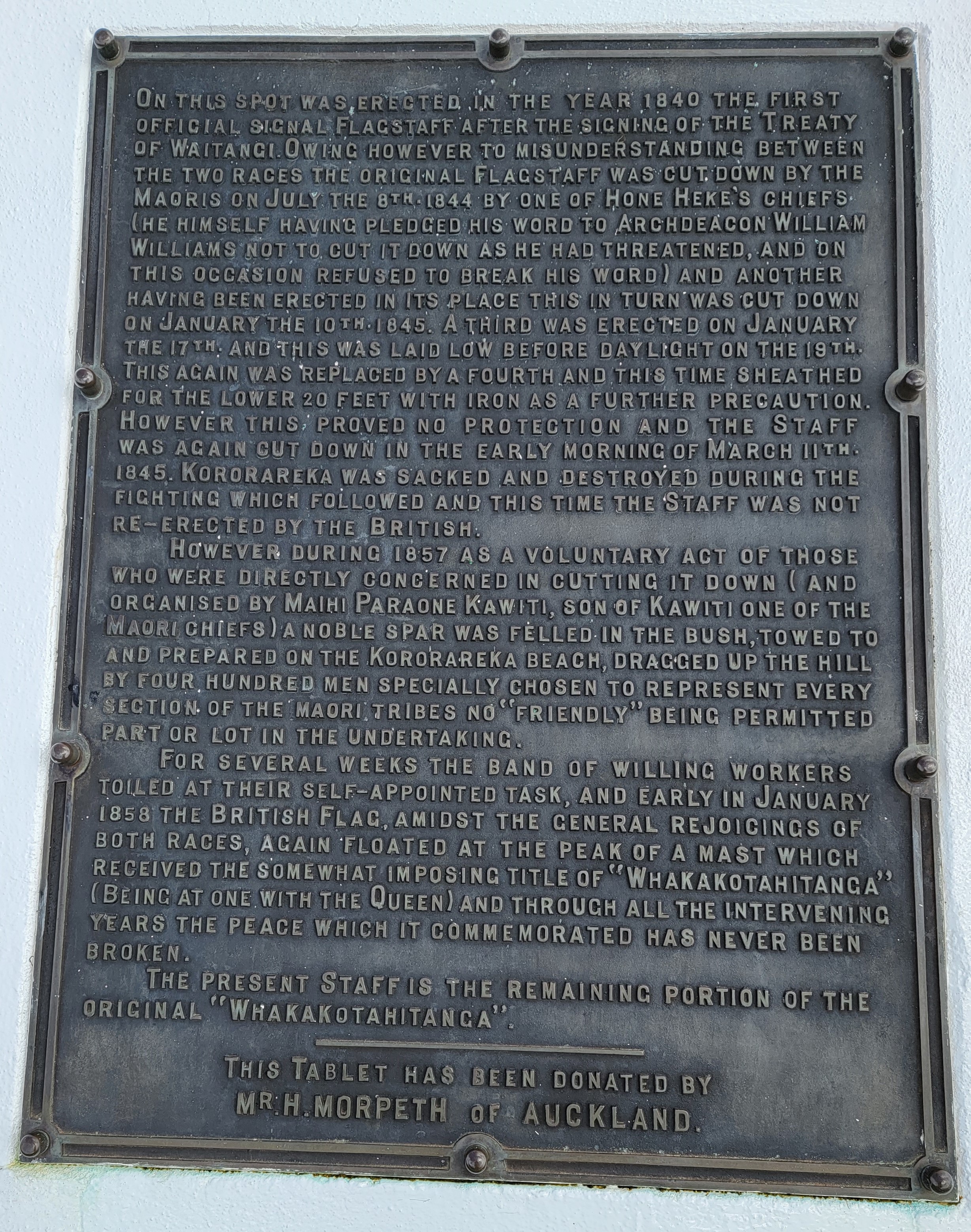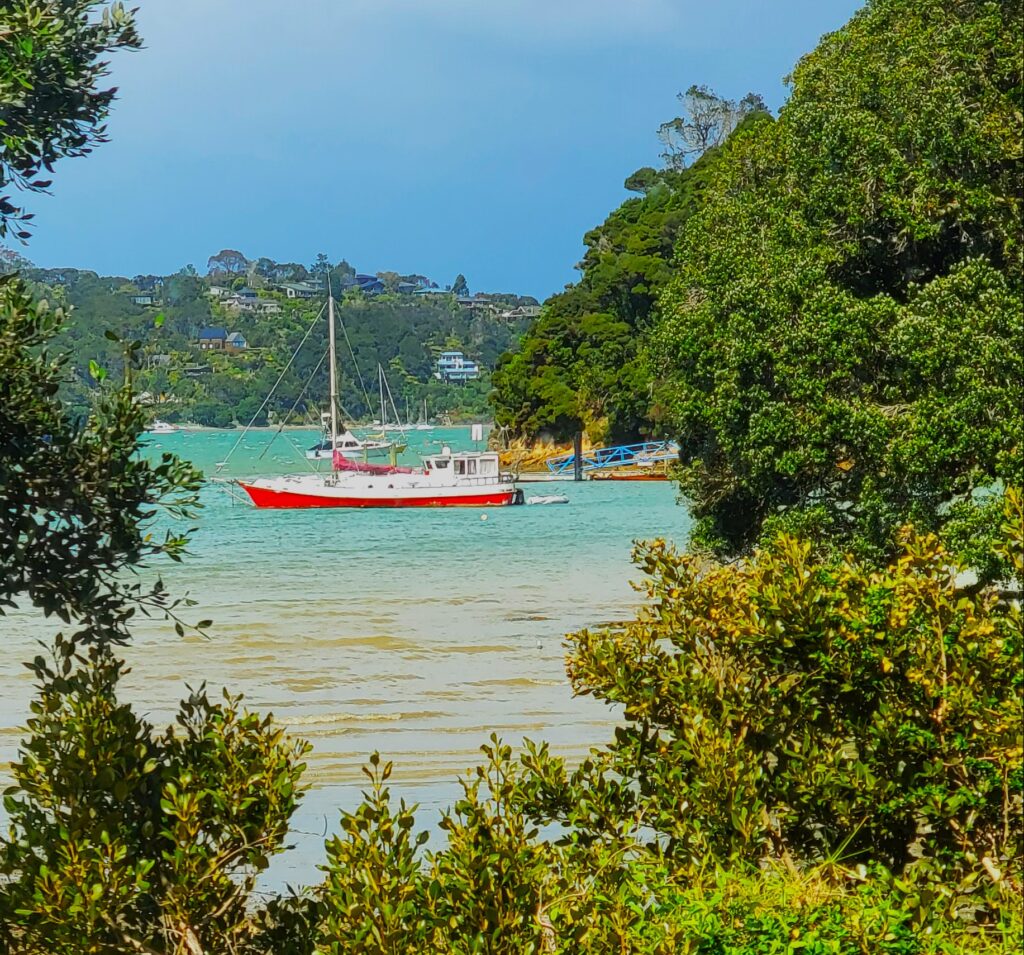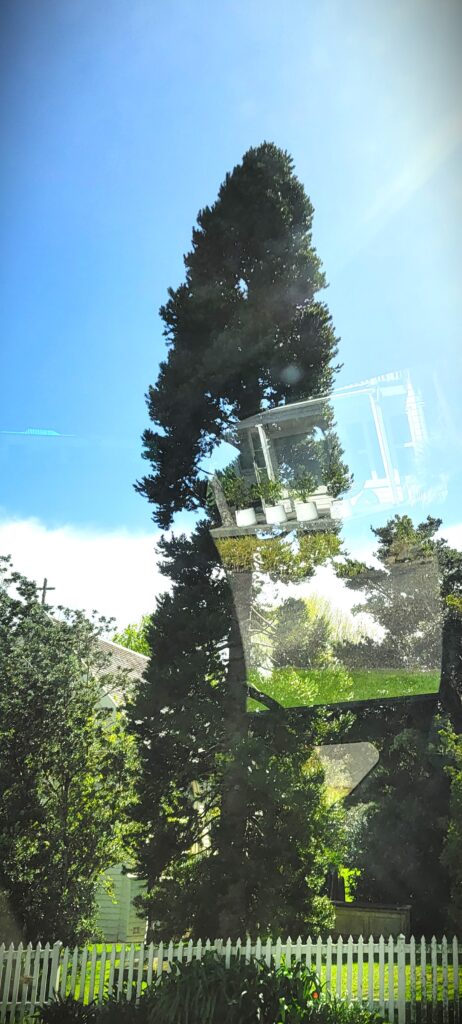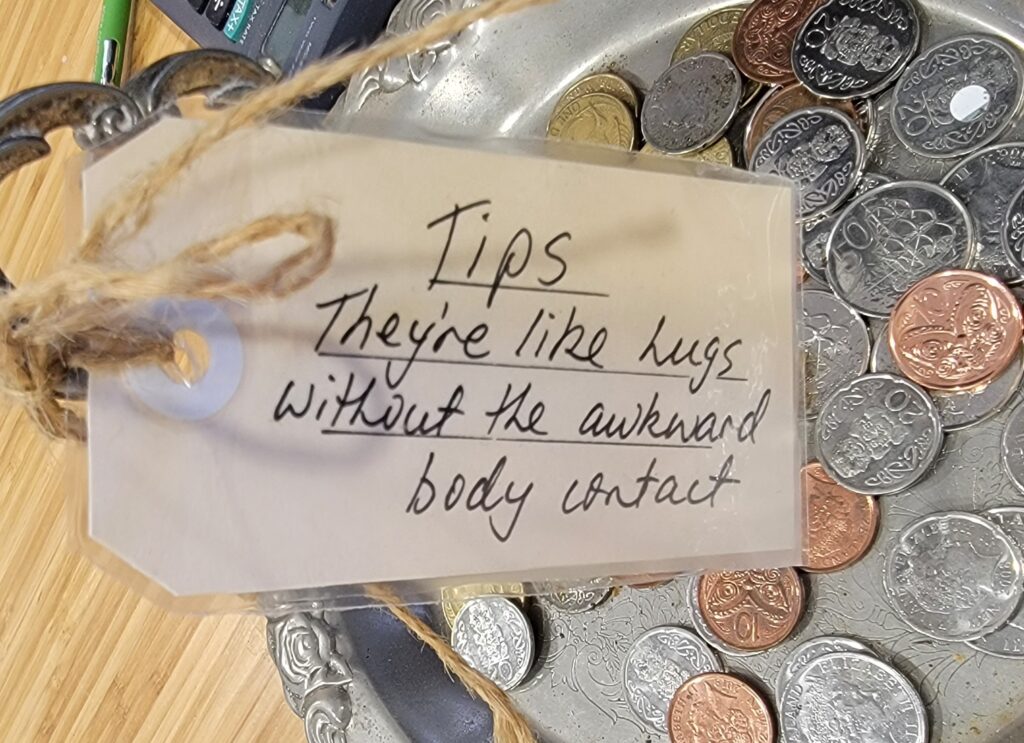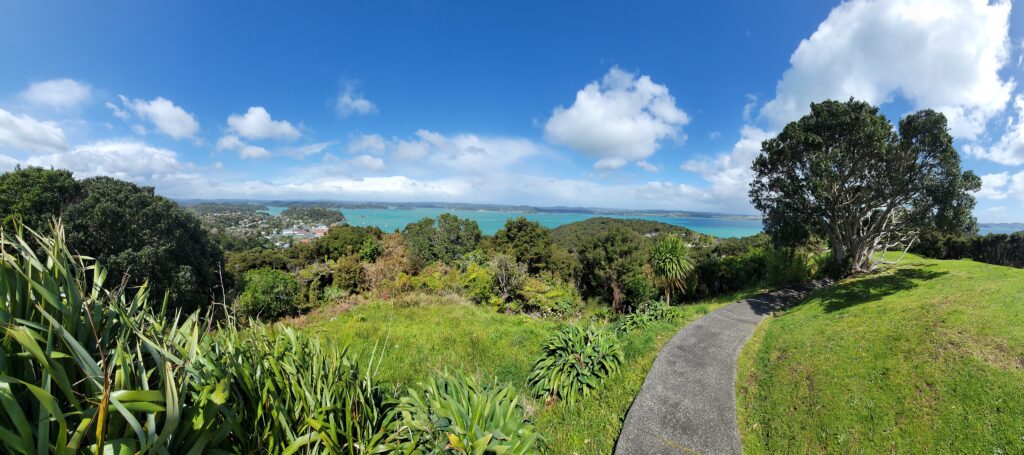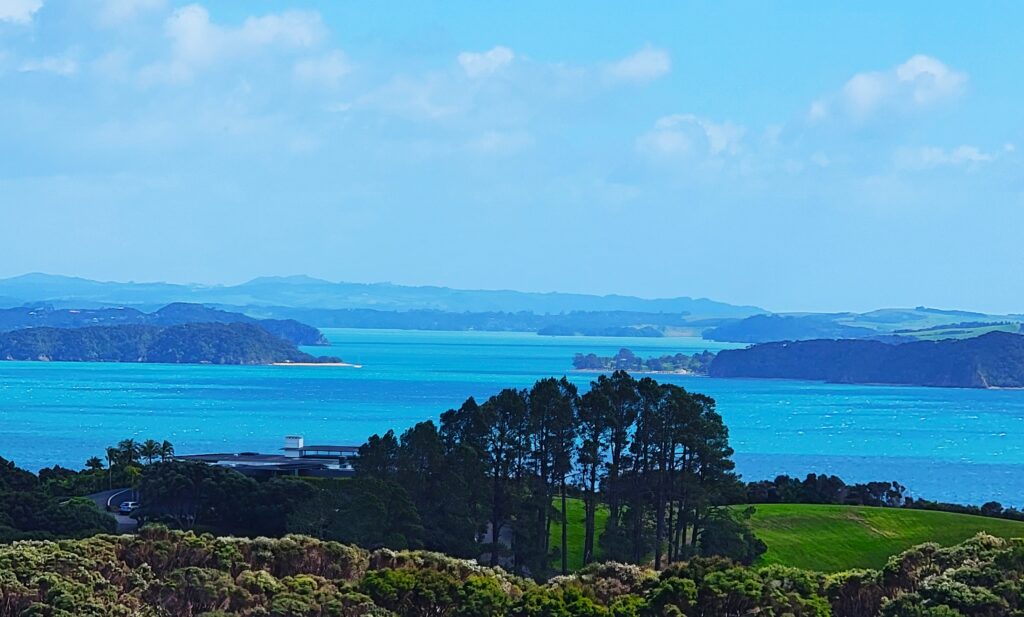This is a “Waratah” – New South Wales, Australia’s flower. We drove past it in the van in Russell and Chris, our van driver and tour guide (originally from Scotland) told us about it. I thought it was really interesting looking!
The Bay of Islands is made up of 144 islands. We are staying in Waitangi, and were driven this morning over to Paihia to meet the ferry to Russell. Paihia is a touristy little town – though of course, we’re out of the tourist season, so it was mainly touristy shops without a lot of people!
I did find another shirt for my daughter in case the first one doesn’t fit (and some cute socks), and some “stocking stuffers” for my grandboys. I also bought a fridge magnet for my daughter’s manicurist, who had done my “Māori-style” nails that are getting a lot of Ooos and Aaaahs from local staff. It is a green “arrow” like they have on their highway exit signs, and says “Middle Earth” (with the arrow). She’s a big Lord of the Rings fan, and I hope will like it. At the Paihia Dollar Store, I also bought Marilyn (of Jim and Marilyn – she’s the only Marilyn left now) a pack that had dice and some playing cards in it, because she said that, what with the weather, “of all trips,” she couldn’t believe she hadn’t brought her playing cards (dot dot dot).
The weather was very blustery and rainy when we headed out to Paihia, and it continued on the ferry to Russell. You needed “sea legs” to get off the ferry and onto the land, as the dock was heaving up and down. And it was a big dock, too!
We met with Chris, a spry 80 year old, at the dock with his van. Rod stayed behind to try to figure out what was up with the weather, our remaining tours, etc. He is certainly earning his salary these past few days! Chris was Scottish, so had a bit of a lilt in his voice. He was wearing shorts – which made me cold just to look at! – but he said it was that or a kilt, and the kilt “kep’ blowin’ up in da wind…” ;-)
So here are some tidbits about what we learned on our trip around the island, plus some photos (not that many). As I type this, I’ve decided not to head out to the dinner tonight in Paihia. Though it sounds like a great restaurant (The Swordfish Club), it’s a “pay your own way” dinner and I’m a little bit exhausted/want to keep the blog updated/want to just be quiet. So – here we go, with “tidbits” and photos :-)
In Russell, like on Waireke Island, a number of the homes were shipped over “whole” from the mainland. It’s less expensive than building them! Also like Waireke Island, the island doesn’t have water – each house has a rainwater catchment system.
Zane Grey (yes, that Zane Grey, the writer of “potboiler” Westerns), per Chris, “single-handedly” put New Zealand on the map for big fish sport fishing. Here is a bit about him:
In addition to his 57 Westerns, Grey also released 8 books about fishing throughout his career. One of these, the beautifully-written Tales of the Angler’s Eldorado, was penned in 1926 about his time in New Zealand. He tells of some of his best catches in the region, described his saltwater and freshwater fishing experiences, and detailed many of New Zealand’s uniquely wonderful environmental and geographical characteristics.
He also wrote many articles for international sporting magazines over the years, which described New Zealand, and in particular the Bay of Islands, as a world class game fishing region. He is widely credited today with playing a huge part in the foundations of New Zealand’s modern fishing industry.
In Tales of the Angler’s Eldorado, Grey said, “The New Zealand coast is destined to become the most famous of all fishing waters. It will bring the best anglers from all over the world.”
Well, we can’t really argue with that.
In showing us around the island, Chris explained that houses like the 2-story stucco one he lived in, which we drove past, can’t be built any more in Russell unless they fit within the “historical template.” In showing us what that looked like, he drove us past homes with copper gutters, and foundations made of crushed whale bones – ! These homes also are built from Kauri wood, which is endangered now. The “historical accuracy folks” just mean to make it fit within the “template” – not actually use the materials – so I think the Kauri and whales are safe :-)
We drive past a Māori meeting house. This is the flag of the United Tribes of New Zealand, a/k/a the Māori flag. I believe that we will find out more about it tomorrow, when we learn more about the Treaty of Waitangi. We heard a bit about this in Auckland, but Waitangi (where our hotel is located) was where the treaty was actually signed.
But let’s go back in Time, a bit before the Treaty. As we drove around the beautiful island, we learned a good bit about New Zealand history, presented in a very engaging fashion.
Russell was the first capital of New Zealand (for 18 months). Then it moved to Auckland. This upset the Māori, who suddenly had to pay tax on items for “export” to the capital. Then, when the South Island was settled, the capital was moved to Wellington, which is more central.
We have heard a few times now that Tasman was the first to “discover” New Zealand, but Chris explained that he really only circumnavigated it. When Tasman came close to land, Māori gathered on the beaches, doing the haka (remember the war dance from a blog post before?) So, he decided to just move on . . .
Captain Cook was next, then ultimately 50 white folks decided to emigrate. They were met by 120 Māori on the beach doing the haka . . . but of course, the white folks just kept coming, and ultimately Russell got its nickname as the “Hell Hole of the Pacific.” This small town in the early 1800s had 17 grog shop/brothels! The whaling ships would use it as a port of call due to the deep water areas (and women willing to enter into “three week marriages”); even convicts on their way to Australia would jump ship in Russell to escape. The area didn’t have any police force until the 1830s, but even after, they weren’t particularly effective to stem the tide of licentiousness.
Christ Church in Russell is New Zealand’s first church. One of the first donations for its construction came from Charles Darwin, who could not believe the “very refuse of society” that he saw in Russell. The cemetery includes headstones for Tamati Waka Nene, who was one of the first chiefs to sign the Treaty of Waitangi (and sided with the British during the Battle of Kororareka). Also there is Hannah King Letheridge, the first white woman born in NZ, and graves of some of those who fell in the Battle of Kororareka. (More on that later.) The Church still shows the scars of the Battle of Kororareka, with musket holes clearly evident.
However, to give services at Christ Church, the Anglican missionaries would row over from Paihia. They had no intent of living over in Russell. In other words, these missionaries stayed on the mainland (Heaven) and wouldn’t come to Russell (Hell). However (per Chris), Catholic missionaries came out, and “bypassed Heaven, going straight to Hell.” They founded the Catholic church, and built some of the first industry in New Zealand (e.g., a bookbindery and hide tannery for making books).
In the beginning when the white folks were mainly whalers (and the people that serviced them), the Māori were fairly happy to co-exist with the whites, trading kaori trees (for masts), guiding, information, women, etc. for white “stuff” (such as guns, alcohol, shovels, etc.) However, ultimately, England sent “settlers” to “tame the land,” and this was a problem, since these settlers wanted to be the “traders,” they didn’t want to trade with the Māori.
As we’ve heard before, ultimately this lead to the Treaty of Waitangi to get things sorted out. The Treaty had two versions to sign – one in English, one in Māori. The English version made it clear that the Māori were agreeing that they would be subservient to Queen Victoria and her governor. The same paragraph in the Māori version stated that “All people would be equal.”
Of course, once it was signed, Māori were forbidden from owning or purchasing shovels, guns, alcohol, or anything that could be used as a weapon. They were also forbidden from entering the schools. They had been promised (when they sold the land for the churches) that Māori and Pākehā (non-Māori) had the same right to burial in consecrated ground. Of course, after the Treaty – Nope.
Hōne Heke, who had been a signatory on the Treaty, ultimately ran up Flagstaff Hill and chopped down the Union Jack, telling the then-current governor that the Treaty was over, it was not as had been portrayed. The British put the flagpole back up – Hōne went back and cut it back down. I believe four times. The English had 1,500 soldiers, and Hōne Heke gathered 850 Māori tribesmen, all from different tribes, which was unheard of. (They were used to fighting each other, not presenting a united front.) The Māori defeated the English, who complained that the Māori “didn’t fight properly.” They didn’t fight in formation, carry a battle flag, regiment in straight lines, etc. (Sounds like the British v. that other rambunctious colony in the 1700s, eh?)
Ultimately Hōne Heke blew up the British munitions dump, and all the whites retreated to the Navy ships in the harbor. While they tried to attack the Māori from the sea, Hōne Heke’s folks destroyed everything down to the ground, except for the churches. This was because Hōne Heke was a “very Christian man” – so much so that he had been baptized Catholic, then Anglican, then Methodist!
I’m sure that we will learn a lot more about this period of history tomorrow.
As I mentioned, we learned a “scatter gun” of Russell history from Chris. There are 73 children in the school now – from kindergarten through “when their parents decide to send them to the Mainland.” (I’m guessing 8th grade? I didn’t ask.)
There were a few more signs that I wasn’t able to take photos of out of the van, such as the “Naughty Penguin” restaurant and “Hell Hole” Coffee. Caught this one though:
But back to the “Hell Hole.” In 1841, “Johnny Johnston’s Grog Shop and Brothel” got the first liquor license in New Zealand; he changed its name to The Duke of Marlborough to be more respectable. HERE is a bit about its history, which actually gives a very concise history about the island! We will be having our farewell dinner (for the 11 of us left on the tour) tomorrow night. (WOW, already?)
Chris described Russell of the 1800s as “A huge, steaming, bawdy town of whalers, grog shops, and brothels.”
There are kiwi signs all over the islands. You can’t have your dog off leash, etc. because kiwis still nest here, so the Bay of Islands area is a Kiwi Preserve. I might have mentioned this before, but I tend to like to leave the “Do Not Disturb” on the door, so that they won’t make up the room. I make my own bed, and don’t really need towels every day, etc. (And Lynn has been willing to humor me.) Some hotels have gotten in on the act and give you credits to your “loyalty card” if you do this. At our hotel here, they take the $ that it would take to clean your room, and give it to the Save The Kiwis Foundation, which is resettling kiwis on their island. (I wonder if it’s tied into the Kiwi Hatchery that we visited last week?)
Back to bits and pieces of what we learned. The Eagles Nest is one of the most exclusive hotels in all of New Zealand. The most expensive room is $20,000NZ a night – the “least expensive” is $3,000NZ per night. The hotel owns “from the hill to the sea” in this area. We went up above it and took some photos in the serious wind! Here are a few (including the mosaic up at the top – brrrr!)
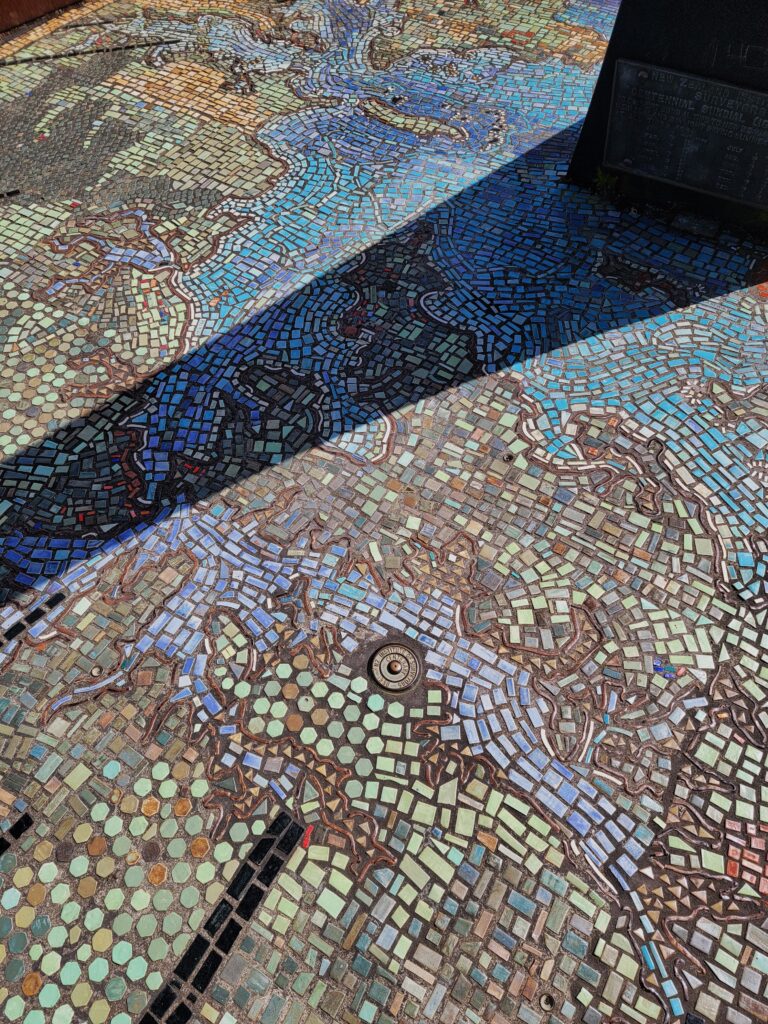

The island is a dolphin, whale, and seal sanctuary (as well as the kiwi). It has a very hilly terrain, with mainly forest inside the hills.
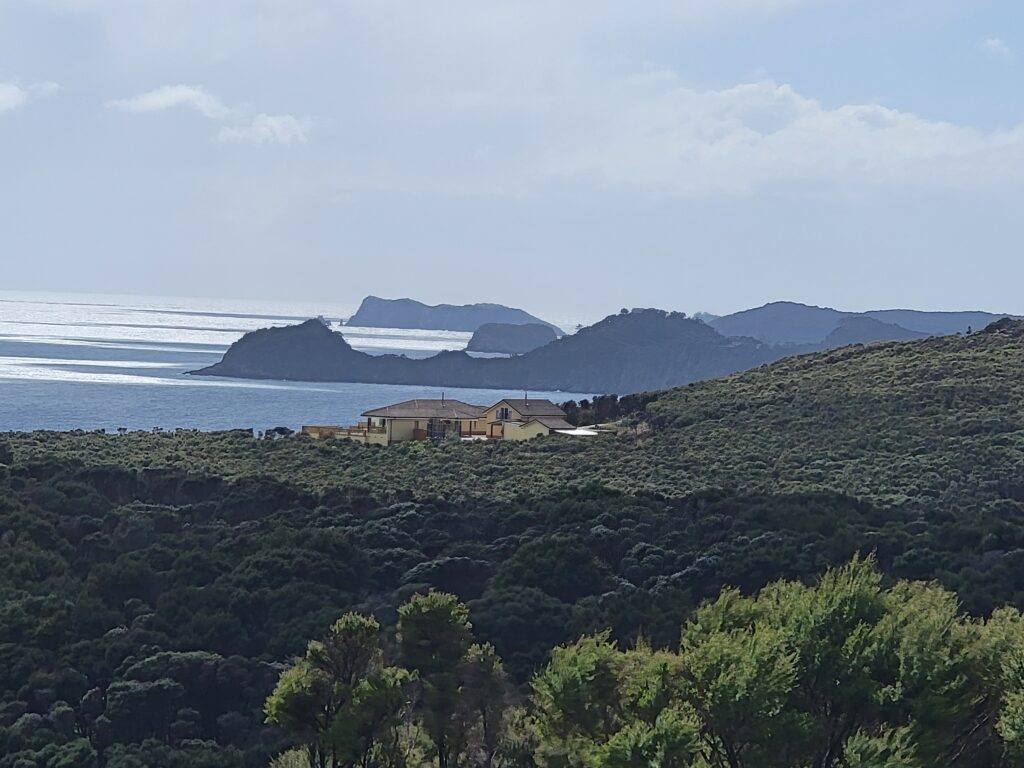
There are many, many multi-million dollar homes. The one above looks out on the most amazing view (same as the Eagles’ Nest!) It was built by two Americans, who have never actually been on the island. The building was finished right before COVID started – now the house is done, but no one has set foot in it. 60% of the homes on the island are Holiday Homes; the “new millionaires” are the locals in the trades (building, plumbing, etc.)
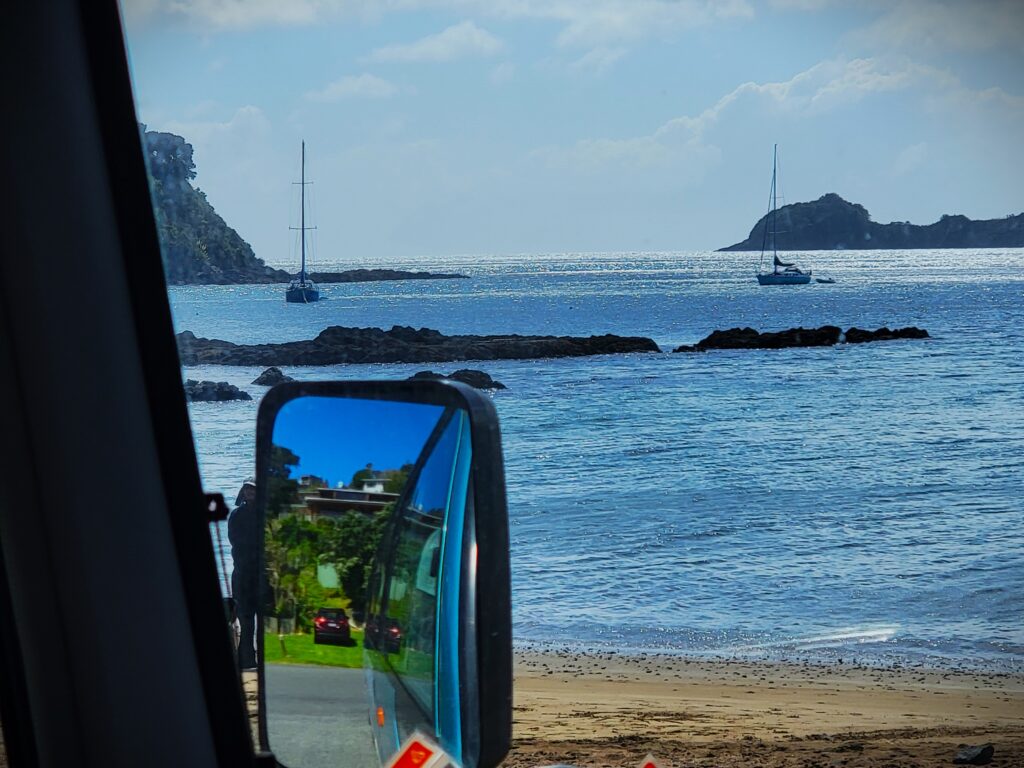
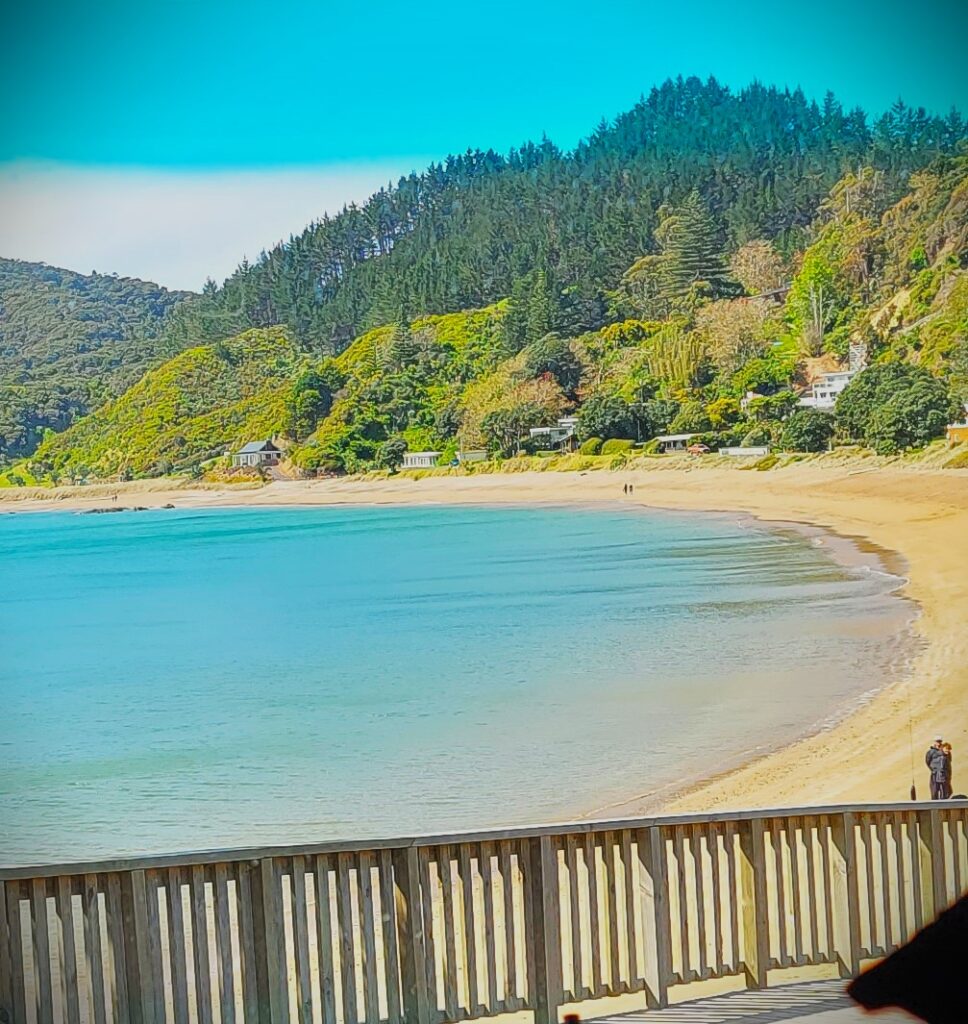
The above is Long Beach, a lovely, sheltered cove on the ocean side of Russell. Off to the left of the first picture (don’t mind the van mirror) is the deep water port, where the cruise ships come in and dock, sending their people onto the land via tenders. It increases the “population” of the islands by 400-500% for a few days! This has been difficult post-COVID, as many people who used to work in hospitality in New Zealand were kicked out – then haven’t come back.
In 1963, Queen Elizabeth commented about the view from this hill – which is now called Queen’s View Road.
Well, that’s about all the notes I have from today. As I type this, it’s lovely and sunny outside the sliding door of our ground floor room. It has a glassed-in lanai sitting area looking out on the garden and (to the far right) the tennis court. Of course, when I started typing, it was hailing!
Tomorrow – the Treaty, a Māori celebration (I’m guessing that a haka will be involved), a boat trip to the Hole In The Wall (where Lynn plans to leave her marble), and (maybe?) a trip to the Hundertwasser Museum. That seems like a lot – I really really hope the Museum doesn’t get lost in the shuffle. Our plane doesn’t leave until quite late, so maybe the idea was to visit on the way back to the Auckland Airport! Wow – we’re already leaving – ????
If you want $100 off, call OAT at 1-800-955-1925 and request a catalog, tell them you were referred by Sandy Shepard, customer number 3087257, and get $100 off your first trip!


